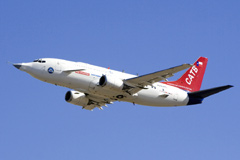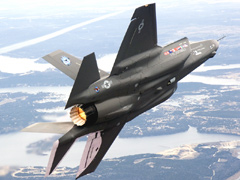
| F-35 'CatBird' Test
Bed Achieves Initial Goals |
||
|
2/12/2007 - FORT WORTH, TX -- The Cooperative Avionics Test Bed, a highly modified 737 designed to validate the Lockheed Martin F-35 Lightning II’s powerful avionics, has satisfied all test objectives within its initial flight-clearance envelope. The “CATBird,” which has completed eight test missions and logged 24.8 hours, is now poised to receive additional flight clearance. CATBird will develop and verify the F-35's capability to collect data from multiple sensors and fuse it into a coherent situational awareness display in a dynamic airborne environment. “The CATBird test program is executing to plan, with no significant issues,” said Dan Crowley, Lockheed Martin executive vice president and F-35 program general manager. “We will now open up the flight envelope, which is within the 737’s operating limits.” BAE Systems is responsible for the aircraft’s modifications. Meanwhile, the first Lockheed Martin F-35 Lightning II has successfully tested a wide range of aircraft systems and demonstrated uncommon reliability since its inaugural flight December 15. “F-35 AA-1 is truly proving its worth as a pathfinder air vehicle. Complex subsystems deemed high-risk just a few months ago are performing flawlessly,” said Brig. Gen. C.R. Davis, F-35 program executive officer. “Early flight test results show we are on a path to largely validate the design and aircraft systems – we are not entering a period of discovery.” The aircraft has made a total of seven flights and is proving
its reliability through the flight test program as it proceeds
toward airworthiness certification. “The F-35’s
extraordinary reliability relates directly to the rigorous ground
testing and laboratory testing our team used to validate systems
before we ever flew,” said Doug Pearson, vice president
of the F-35 Integrated Test Force. Revolutionary internal systems on the aircraft have performed exceptionally well, including unique actuators that drive control surfaces primarily using electricity instead of a hydraulic system. Another device that for the first time combines the engine starter, the generator, the emergency power supply and the environmental-control system into a single unit also has continued to operate successfully. The F-35 is a supersonic, multi-role, 5TH Generation stealth fighter designed to replace a wide range of existing aircraft, including AV-8B Harriers, A-10s, F-16s, F/A-18 Hornets and United Kingdom Harrier GR.7s and Sea Harriers. Lockheed Martin is developing the Lightning II with its principal industrial partners, Northrop Grumman and BAE Systems. Two separate, interchangeable F-35 engines are under development: the Pratt & Whitney F135 and the GE Rolls-Royce Fighter Engine Team F136. Source: Lockheed Press Release |
| |

